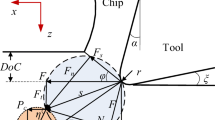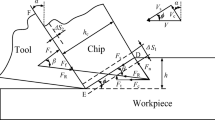Abstract
The end milling of nickel-aluminum alloy has been widely applied to the manufacture of seawater applications, while the prediction of residual stress induced by this process is seldom reported. An analytical model of residual stress is proposed, based on mechanical loading and thermal loading during end milling. For the first time, the sequential discontinuous variable mechanical loading feature of end milling is taken into consideration. Also, the analytical model of stress field in the workpiece during cutting is analyzed which is intermediate variable to study residual stress. Model predictions are compared with experimental data and FEM method for cutting forces, cutting temperature, and residual stress.
Similar content being viewed by others
Change history
01 October 2018
The affiliation of the original version of this article contained a mistake. The correct affiliation is shown below.
01 October 2018
The affiliation of the original version of this article contained a mistake. The correct affiliation is shown below.
01 October 2018
The affiliation of the original version of this article contained a mistake. The correct affiliation is shown below.
01 October 2018
The affiliation of the original version of this article contained a mistake. The correct affiliation is shown below.
References
Thossatheppitak B, Uthaisangsuk V, Mungsuntisuk P, Suranuntchai S, Manonukul A (2014) Flow behaviour of nickel aluminium bronze under hot deformation. Mater Sci Eng A 604:183–119
Ulutan D, Özel T (2011) Machining induced surface integrity in titanium and nickel alloys: a review. Int J Mach Tools Manuf 51:250–280
Guo YB, Li W, Jawahir IS (2009) Surface integrity characterization and prediction in machining of hardened and difficult-to-machine alloys: a state-of-art research review and analysis. Mach Sci Technol 13(3):437–470
Denkena B, Nespor D, Böß V, Köhler J (2014) Residual stresses formation after re-contouring of welded Ti-6Al-4V parts by means of 5-axis ball nose end milling. CIRP J Manuf Sci Technol 7(4):347–360
Arrazola PJ, Özel T, Umbrello D, Davies M, Jawahir IS (2013) Recent advances in modelling of metal machining processes. CIRP Ann Manuf Technol 62(2):695–718
Li B, Jiang X, Yang J, Liang SY (2015) Effects of depth of cut on the redistribution of residual stress and distortion during the milling of thin-walled part. J Mater Process Technol 216:223–233
Rao B, Dandekar CR, Shin YC (2011) An experimental and numerical study on the face milling of Ti–6Al–4V alloy: tool performance and surface integrity. J Mater Process Technol 211(2):294–304
Jawahir IS, Brinksmeier E, M'Saoubi R, Aspinwall DK, Outeiro JC, Meyer D, Umbrello D, Jayal AD (2011) Surface integrity in material removal processes: recent advances. CIRP Ann Manuf Technol 60:603–626
Merwin JE, Johnson KL (1963) An analysis of plastic deformation in rolling contact. Proc Inst Mech Eng 177:676–690
McDowell DL (1997) Approximate algorithm for elastic–plastic two-dimensional rolling/sliding contact. Wear 211(2):237–246
Jiang Y, Sehitoglu H (1994) An analytical approach to elastic–plastic stress analysis of rolling contact. J Tribol 116:577–587
Jacobus K, DeVor RE, Kapoor SG (2000) Machining-induced residual stress: experimentation and modeling. Trans ASME 122:20–31
Liang SY, Su JC (2007) Residual stress modeling in orthogonal machining. CIRP Ann Manuf Technol 56(1):65–68
Ulutan D, Alaca E, Lazoglu I (2007) Analytical modelling of residual stresses in machining. J Mater Process Technol 183:77–87
Agrawal S, Joshi SS (2013) Analytical modelling of residual stresses in orthogonal machining of AISI4340 steel. J Manuf Process 15(1):167–179
Yan L, Yang W, Jin H, Wang Z (2012) Analytical modeling of the effect of the tool flank wear width on the residual stress distribution. Mach Sci Technol 16:265–286
Huang K, Yang W, Chen Q (2015) Analytical model of stress field in workpiece machined surface layer in orthogonal cutting. Int J Mech Sci 103:127–140
Su J, Young KA, Ma K, Srivatsa S, Morehouse JB, Liang SY (2013) Modeling of residual stresses in milling. Int J Adv Manuf Technol 65(5–8):717–733
Fergani O, Lazoglu I, Mkaddem A, El Mansori M, Liang SY (2014) Analytical modeling of residual stress and the induced deflection of a milled thin plate. Int J Adv Manuf Technol 75(1–4):455–463
Fergani O, Jiang X, Shao Y, Welo T, Yang J, Liang S (2016) Prediction of residual stress regeneration in multi-pass milling. Int J Adv Manuf Technol 83(5–8):1153–1160
Huang X, Zhang X, Ding H (2015) An analytical model of residual stress for flank milling of Ti-6Al-4V. Procedia CIRP 31:287–292
Zhou R, Yang W, Yang K (2016) Force prediction models for helical end milling of nickel-aluminium bronze. Int J Adv Manuf Technol. doi:10.1007/s00170-015-8261-1
Komanduri R, Hou ZB (2000) Thermal modeling of the metal cutting process: part I—temperature rise distribution due to shear plane heat source. Int J Mech Sci 42:1715–1752
Lee S, Lee W (2005) Finite-element analysis on thermomechanical behavior of a marine propeller casting in the sand-casting process. J Mater Eng Perform 14(3):388–394
Third Wave Systems, Inc (2010) AdvantEdge v5. 6–014 Machining simulation software. Minneapolis MN
Author information
Authors and Affiliations
Corresponding author
Rights and permissions
About this article
Cite this article
Zhou, R., Yang, W. Analytical modeling of residual stress in helical end milling of nickel-aluminum bronze. Int J Adv Manuf Technol 89, 987–996 (2017). https://doi.org/10.1007/s00170-016-9145-8
Received:
Accepted:
Published:
Issue Date:
DOI: https://doi.org/10.1007/s00170-016-9145-8




